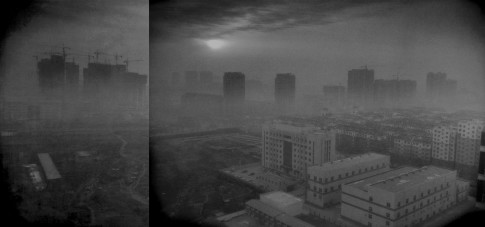From the article:
“The bottom line: With the restructuring of the steel and cement industries, Hebei may lose at least 200,000 steel jobs.”

Smog envelopes Xingtai, China, at dawn in southern Hebei province.
More photos here:
– Air Pollution Turned This Chinese City Into a Ghost Town (Bloomberg, Feb 26, 2015):
The city of Handan in Hebei province is the birthplace of Qin Shihuang, the first emperor of China. That illustrious history isn’t apparent today. Aging, coal-burning steel factories belch grime over the city of 1 million, one of China’s 10 most polluted. Dotting the downtown area are half-constructed high-rises, relics of a property bubble that started more than five years ago but was finally punctured last summer after the central government in Beijing curtailed credit and developers stopped paying creditors. Locals who lost their savings in dodgy real estate investments regularly block city streets in angry protests, demanding their money back from the developers.
The collapse of the property market is only one of Handan’s problems. Hebei province, which nudges up against Beijing, is heavily industrial, and in China, heavy manufacturing means pollution. The sulfur dioxide, nitrogen dioxide, and dust from Hebei’s smokestack industries end up fouling the air of Beijing, and the government wants to make the capital breathable again. The only solution is to wean Hebei off manufacturing.
Last year the province’s economy was one of China’s worst-performing, growing 6.5 percent, below its 8 percent target. Hebei’s mills produce some 25 percent of China’s more than 800 million tons of steel. The province is one of the country’s biggest glass and cement manufacturers. All three industries face serious oversupply, much of it built up since cheap loans became available after the 2008 global financial crisis. China’s steel factories run at 72 percent of capacity: A mill generally has to run at 80 percent to make a profit.
Under pressure from top leaders, provincial authorities have promised to cut capacity in steelmaking and cement manufacturing by 60 million metric tons each by the end of 2017 and reduce coal use by 40 million tons.
Thousands of factories have already been closed, and thousands more will suffer the same fate. “Our economy is collapsing, and we are facing a crisis,” says Wang Lihe, a cab driver for the past five years. He says his monthly earnings have dropped from 5,000 yuan ($800) last summer to 3,000 yuan to 4,000 yuan today. “My place used to be full. Now look at it,” says Su Xiushang, whose empty restaurant sits near the east gate of Handan Iron & Steel, the city’s biggest mill. “Handan was a rich town with its history and steel. Now regular people can’t even afford to eat out.”
By the time Hebei finishes restructuring its industries, an estimated 200,000 steel jobs will be gone, the Hebei Provincial Development and Reform Commission says. The factory shutdowns fit with a national plan to consolidate steel production in larger, more efficient mills closer to the ports that bring in Australian iron ore, says Michael Komesaroff, principal of Urandaline Investments, a Melbourne-based consulting firm. “The transition is coming at a much faster rate and on a larger scale than had been previously anticipated. That’s making it much harder for everyone to manage,” Komesaroff says.
China’s leaders are trying to bolster the province’s economy through a regional development plan called “Jing-Jin-Ji,” short for Beijing, Tianjin, and Hebei (“Ji” is a one-character traditional name for the province). Endorsed by President Xi Jinping last year, it calls for expanding the network of roads and high-speed rail. Some government offices, as well as most of Beijing’s wholesale markets in clothing and household goods, will be moved to Hebei to relieve congestion in the capital and create jobs in the province.
Earlier nationwide efforts to consolidate the steel industry foundered as local governments resisted closures that would have led to job losses and tax revenue shortfalls, says Komesaroff. The latest attempts may as well. “Our equipment is backward, and yes, we are polluting the skies, but we have maybe 30,000 workers—this factory is the biggest employer here,” says a worker eating beef noodles in a cafe by the main gate of the Handan steel factory. His employer, a subsidiary of China’s largest steelmaker, Hebei Iron & Steel Group, is ultimately controlled by the central government. “All of our revenues go to Beijing. They won’t shut us down.”
The bottom line: With the restructuring of the steel and cement industries, Hebei may lose at least 200,000 steel jobs.
Together with BigAgri land pollution, River Pollution, Plastic oceans, Chemtrails, it definitely looks like we the people have allowed the Industrial Complex to poison our biosphere.
We deserve it all for trusting greedy people.
http://www.awaresy.com/air-pollution-caused-4-2-million-early-deaths-worldwide-new-study-813/?utm_source=feedburner&utm_medium=email&utm_campaign=Feed%3A+TheTotalCollapse+%28Awaresy%29
Nice….
http://www.awaresy.com/salmon-tests-positive-for-cocktail-of-80-drugs-including-cocaine-and-prozac-536/